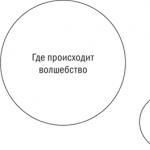The popular WhatsApp messenger, installed on millions of mobile devices by users in all countries of the world, and not telephone networks. But even if he knew how to connect through telephone channels, nevertheless, a justified question arises: how much traffic does Vatsap consume. Let's talk about how expensive it is to use.
How much traffic does WhatsApp consume
It is not possible to answer this question unambiguously. There are not one or two types of data that WhatsApp processes, and they have different “weights”. Although it is clear that most of the available bandwidth is clogged by the transfer of video files or even continuous streaming, and least of all by the exchange of short messages in the chat. And the ratio of different types of communication is individual for everyone. It is enough for someone to log into their account a couple of times a day and exchange a few phrases with someone, while someone prefers to continuously stream everything around in HD quality. It is clear that the cost will be completely different.
Also keep in mind that WhatsApp, like other similar programs, is usually always on. If the smartphone is in the coverage area of an open network with Internet access, Vatsap independently begins to communicate with its servers. And when you leave the access zone, this transmission stops.
All this leads to the fact that it is very difficult to say exactly how much traffic Vatsap “ate” today or yesterday.

Call traffic consumption
You can put the question in a different way. For example: “How much data does WhatsApp use for one minute of a voice call?” This can be said more or less accurately. From practice it is known that one minute of conversation will "weigh" from 1 to 1.3 megabytes. This figure should be taken into account when calculating. Compare your tariffs for mobile calls and for the Internet, and draw a conclusion about which and how much more profitable.
And at the same time, of course, you need to keep in mind that if you are constantly in the coverage area of free Wi-Fi, then for you in general any type of WhatsApp traffic will be free!
How to calculate traffic consumption in whatsapp
Any operating system has built-in tools for measuring traffic consumption. Depending on the modification, these tools are located in different places, for example, "Settings - Internet traffic" or "Settings - Data usage". One way or another, regular OS tools usually allow you to see how much traffic a particular application “ate” for various periods of time. You can search this WhatsApp list and check how talkative you are.

If you do not have enough general information, and you want accurate detailing, you can use third-party programs for this purpose.
For example, My data manager is one of the typical applications of this kind available on Google Play. Allows you to monitor the consumption of Wi-Fi traffic and mobile data both in the home region and in roaming, set up alerts about possible overruns in excess of the established limits. You can always see how many minutes or text messages are left in the set tariff plan. There is a special widget that will always be active on the desktop. It allows you to estimate the total consumption at a glance without opening any applications. You can manage several devices at once, track statistics for different periods, and so on.
There are several dozens of similar programs for traffic control, and you can find a suitable solution for yourself.
The world-wide popular instant messenger WhatsApp has received the ability to make voice calls. So far, it has only been implemented for Android.
To start calling via WhatsApp, you need to install the latest version or update the application.
Having installed one today under Windows Phone 8.1, I have not yet found the call function. It is not yet available under iOS either, however, owners of unlocked iPhones can enable the option on their own at their own risk.
After installing the latest WhatsApp under "Android", open a chat with a contact and pay attention to the top panel, where an image of a handset will appear on the right. Click on it to call the interlocutor. Calls can only be made to subscribers who have WhatsApp installed, and with a version that supports voice calls.
Also in the main window of the program there is now a “Calls” tab, a speakerphone function and the ability to send text messages directly during a conversation.
Of course, you can make calls only when connected to the Internet (both mobile and Wi-Fi). Data transfer must also be active for your interlocutor. Although in our age of Internet smartphones and tablets, it is logical that the mobile Internet should work on them almost constantly.

In addition to WhatsApp, the voice option is also present in its direct competitor - Viber. True, in Viber, unlike WhatsApp, it is also possible to call numbers that are not directly connected to the messenger - for money. In WhatsApp, for now, there is only free voice communication between its users.
Actually, there are many options for free IP telephony now. In addition to the above examples, you can immediately name other mobile applications with the function of voice calls: Google Hangouts and Facebook Messenger.
I would like to add that at the moment the WhatsApp application is used by over 700 million people around the world. At the same time, the popularity of an extremely convenient application is only growing. This is also facilitated by the recent release of its desktop version (albeit extremely poor in its implementation) and even a "virtual operator".
I would like to add on my own that I would like to add the ability to make calls with good audibility even with a slow Internet connection (similar to Viber), for example, via EDGE, to the advantages of WhatsApp. The application is not at all demanding on traffic (unlike poor Skype) and you can use it even just moving along the street, and not being in the Wi-Fi coverage area. Thus, another opportunity to save on mobile communications and roaming appeared. Another advantage of the program is that the caller will display your contact (number) on the display, and not the gateway phone, as is often the case with IP telephony providers.
In business
Testing showed the following. I talked on WhatsApp over Wi-Fi, my interlocutor called me through the Beeline mobile network (EDGE) on the road. The audibility was excellent, but a jamb was noticed (the same on both sides). My voice speaker is at minimum volume, and the ringtone is at maximum. At the same time, the WhatsApp conversation began at maximum volume. It feels like I put a speakerphone to my ear. At the same time, pressing the volume rocker down during a call did nothing. It was possible to reduce it only by removing the smartphone from the ear when the light sensor worked.
In general, everything works somehow the other way around. It turns out that by reducing the volume of the conversation on the watsap to a minimum, I, thereby, lowered the volume level of the phone ringtone. So, after the conversation, I should not forget to return it to its previous value. And so every time?!
By the way, Vibera has a similar jamb, but vice versa: in order to hear the interlocutor, I have to bring the volume rocker to the maximum during the conversation.
With the IP-Phone application (Comtube) it’s even worse - first I have to call any number in the standard way, set the volume of the conversation to the maximum, and only then call through the IP-Phone application, because otherwise it will be too quiet during a call and make nothing will succeed.
Perhaps there is a jamb directly in Android, but I'm not sure. As for the WhatsApp conversation itself, it took place (the connection was even better than via Viber), but it was interrupted in the process and the application could not restore it. Communication with another contact (both were connected via Wi-Fi) also ended in a break, however, the application restored the connection.
Many people are interested in the question of what viber and vatsap are, what are their advantages and differences. These are applications that users install on a device that allow them to instantly exchange information. They are the most popular among existing programs. This is due to their compatibility with tablets and smartphones running on the following operating systems: Windows, Android, iOS, Symbian. Some consumers install both applications on their smartphone. This allows them to expand their ability to communicate with other users. Consider how to connect WhatsApp and Viber to a mobile device.
Advantages of a viber and its installation on a device
The idea of creating Viber belongs to Talmon Marko, a native of Tel Aviv, and his partner Igor Magazinnik, a native of Russia. The app was first launched in Israel. 18 users installed it on their mobile device. Already after 3 weeks there were more than 30 thousand of them, a month later the number of people using Viber became about two million. This speaks to how convenient and economical it is. Due to the fact that it is free, people living in different parts of the world can communicate with each other, send messages, photos and all kinds of images. To install Viber, you need to perform the following steps:
- Go to Play Store on your Lenovo or other smartphone.
- In the window that opens, find the required application. If it is not there, you need to enter its name in the search bar.
- As soon as a purple icon appears on the screen, inside of which there is a handset, you must click on the button labeled "Install".
- On the new image that appears, you need to find the "Accept" button, click on it. After that, the installation of the application will start.


- Once the installation is complete, you should click on the "Open" button, after which an image will appear inviting you to join.
- Now you need to go through a simple registration. In the window that opens, enter the country of residence, indicate the number of a valid phone.

The second method involves taking the same steps as when installing a viber.

The benefits lie in the ease of use of the application. It does not need login and password water. There is no need to manually add contacts, they will automatically appear in the phone list if users have this program installed. A characteristic feature of WhatsApp is its extreme conciseness, there is nothing superfluous in the application, everything is clear and precise.
Differences between viber and whatsapp
Many application users are interested in how Viber differs from WhatsApp. In fact, there are not so many differences, they are as follows:
- WhatsApp does not allow video calls, unlike Viber;
- viber is a free application, you will have to pay for whatsapp after the first year of use;
- WhatsApp lacks the colorful, vibrant stickers that Viber boasts;
- You can install a viber on a PC, but this option is not provided for WhatsApp.
Based on this, it is quite difficult to conclude whether Viber or WhatsApp is better. If users are interested in such a function as video calls, the first option is more acceptable for them. In all other respects, both applications are functional and convenient.
If earlier we had to spend a lot of money on calls and SMS, today we can do it completely free of charge using VoIP messengers, the leaders among which are WhatsApp,. These mobile applications have their own advantages and disadvantages. And, for example, to find out what is better viber or whatsapp, you will need to explore the capabilities of each of these mobile applications and identify their main differences.
Convenient to use
First of all, it is worth noting the simplicity of both applications. When installing each, you only need to make a binding to a mobile phone number, that is, there is no long and tedious registration with the introduction of a login and password that you need to come up with yourself. We download the program, install it and start using it right away, since all the necessary contacts are synchronized.
The interface of both programs is simple, however, in Viber it is more complicated, but this is due to the fact that it has more possibilities. Therefore, the Internet requirements for this software will be more demanding.
The functionality of both programs
Here, without a doubt, Viber "wins", which allows you to make calls, send messages, photos,. WhatsApp has the same features, with the exception of one (but very important) - it does not allow you to make video calls.
Both programs have such a drawback - they do not allow the transfer of simple documents, which is possible in Skype. In addition, you need to pay for the use of Vatsap after the first year of use.
And Viber and how to use these programs. Well, you can try to give a short and comprehensive answer to these questions.
Messengers and what they eat with
The term “messenger” itself means, in the broadest sense of the word, any program with which you can communicate in one way or another. And today there are a huge number of instant messengers - with a variety of functions. There are messengers for corporate use - only within one enterprise. And there are those with which you can communicate with the whole world.
Surely the old-timers of the Internet remember "ICQ" - ICQ. So this is also a messenger. By the way, "ICQ" is still alive and well, and has changed beyond recognition, acquired new functions. But the main competitors in the market are. In almost all respects, they go head to head. And they are pretty easy to use. Being launched on mobile phones, they allow users to correspond, exchange files and even call from one messenger to another.


This is what the answer to the question of what is a messenger looks like. If someone is interested in which messenger should still be preferred, then no one will answer this question unambiguously.
All programs are good in their own way. But it is WhatsApp that is used by more than a billion people today.
After all, with the help of WhatsApp you can:
- send each other text messages;
- dilute the text with funny emoticons;
- you can also share pictures and videos;
- and, of course, to each other - both through voice communication and through the video channel.
In addition, this program is distributed today completely free of charge and has an official Russian localization.
Let's try to figure out which messenger is better, WhatsApp or Viber. Often we have to use the same means of communication as friends in order to be able to write or call them at all. In this review, we will not take into account the popularity among your friends of a particular application, although this factor is decisive when choosing a messenger.
We have identified three main criteria by which we will compare:
Application Features
Chat
Both apps have decent Chat, which is fun to chat with and has a lot of features. We will not dwell on the same functions in detail, we will only list them:- You can send photos and videos
- Location
- A voice message
- Contact
- Emoticons
Original features in WhatsApp in Chat
Original Viber features in Chat

group chat
You can create your own group and communicate with several interlocutors at the same time in either application, but here Public group chats, with the ability to search for them, is only in Viber.
Contacts
Both applications are integrated into the phone book, there are no significant differences.Free internet calls
Both messengers have an audio call over the Internet (between the owners of the application with an Internet connection), they are on the same level in quality and spend approximately the same amount of traffic.Calls to landline and mobile phone numbers

Only Viber can make a call to a landline or mobile number without Internet access!
This feature is not free, but the rates are not high, and if you want to call to another country, we recommend using the service viber out
Video calls

Interface and Usability
It is difficult to objectively assess the convenience of the application, which is convenient and simple for some, unusual and difficult for others, but nevertheless we will try to demonstrate the advantages and disadvantages of the interface of both programs using examples.
Supported Devices

As for cross-platform, Viber is in the lead here, it has full-fledged versions for various operating systems, which cannot be said about WhatsApp, in order to install it you will have to sweat, but if you use the instruction, it will not be so difficult.
Conclusion
Viber has an undeniable advantage in terms of functions related to calls and video calls, and if you use them, then the choice is obvious for you. But if you only call for free via the Internet and appreciate simplicity and convenience during correspondence, then it’s better to install WhatsApp.Write in the comments what you use and your opinion about these programs.
Now almost every student and adult knows about such programs for communicating on the Internet as WhatsApp or Viber. But why use both, if you can make a choice by comparing them? How to make a choice between WhatsApp, Viber and, for example, Telegram?
Comparison by individual criteria
Price
It is quite possible to start the comparison directly with the price. The WhatsApp application requires payment starting from the second year of use. It is almost one dollar (99 cents). At the same time, the second program - Viber - remains completely free.
Moreover, according to the assurances of the official representatives of this program, as well as numerous publications on the World Wide Web, the application will continue to support such a policy. The only thing that the creators of Viber are going to make money on is the additional new pleasures that come with the program.
They are not any mandatory or integral parts of the mentioned software, therefore, they will not affect the interests of users.
Amount of traffic and features
For those who do not have unlimited or very cheap internet on their device, the comparison point for available traffic will be of interest. Now WhatsApp is taking over: it has a much better traffic supply. On Whatsapp, you can send messages sparingly, while on Viber, you have to pay a lot of money for video calls.
Global features include:
- Whatsapp has sending text, video, audio messages, including pictures, emoticons, holding so-called forward dialogues and conferences.
- Viber is attracted by a feature that allows you to make a video or audio call.
Data security
As for the security, privacy of all Whatsapp or Viber clients, here is the case:
- The first of the programs is necessarily created (in the context of personal use) based on the person's telephone number. All his contacts, respectively, are loaded into the database, and they are also tied to the number. All participants in these systems taken together and those who bought a mobile number using their passport should know the information provided.
- But what about Viber and its privacy and personal data protection capabilities? Here, it turns out, you can put a person on the black list, and the tracking system based on Google Ananlytics can be turned off.
Ability to work in symbiosis with platforms
In order for the mailing to be carried out through WhatsApp, you can use devices such as a phone (not older than Nokia S40_Simbian), a smartphone based on Android or Apple (operating system IOS 3.4 and older), a gadget based on Windows Foun version 7.5. But an even more practical option would be an older version, for example, the eighth. By the way, the "eight" is currently considered the minimum requirement for the successful use of Viber.

Whatsapp on personal computers can also be successfully used (mailing). Windows or Mac will perfectly accept this messenger. At the same time, if you have a mobile client and do not want to download another version of the program, you can install it on your computer. It also fits perfectly with the Blackberry platform.

Viber also supports the Android and Apple platforms, as well as Barberi, Symbiosis, Bada, Windows Foun.
Another difference between WhatsApp: you can’t send voice and video messages, send SMS, make calls to numbers that are not registered in the phone book. Viber has this feature, but it is paid.
Appearance and interface
- WhatsApp is quite attractive, judging by the reviews about the appearance of the program, and the creators regularly come up with ways to simplify the use of already extremely simple software.
- In the next paragraph - the ease of making video calls in the interface of the phone, Viber would win, but the money you spend on this when taking into account traffic makes this application a loser in this battle.
- But in Viber (right during the chat) it is possible to send large sticker pictures! You can draw them directly on the screen with your finger using different colors and tools.
- Groups - this concept is familiar to both programs, but only Viber can search for open (public) group chats. He is able to call even a landline phone (it is also called a city phone), although not for free.
- But in WhatsApp, you just have to want to - and you can delete all unnecessary messages with one touch of your finger, although this cannot be done in the second client under consideration - you will have to clean the folder, deleting one message at a time.
- In Viber, the number of calls in one conference call is limited.
- In WhatsApp, you can send one message at once to a large and unlimited number of system participants.
So, everyone should decide which is better, WhatsApp, Viber or Telegram, based on their communication needs.
As you know, some applications, if left unattended, can consume mobile traffic very well. And these are not only toys, but also mobile messengers that we all love, which most of the time work in the background, but due to their specifics, they receive and send data without stopping at all. This post is about how to save WhatsApp mobile data.
Of course, for starters, it would be nice to conduct a preliminary audit to find out in what volumes WhatsApp generates traffic, and how critical this indicator is within the framework of the selected tariff plan. See how in the settings of the application itself ( "Menu" -> "Settings" -> "Data" -> "Network usage" ), as well as in the smartphone settings.
True, different smartphones do this in different ways, but in any case it is not difficult. For example, in our Huawei, you can see the application work data as follows: "Settings" -> "Data Traffic Management" -> "Data Usage Estimate" -> WhatsApp .
If for some reason you do not trust regular traffic counters, then you can also use a third-party application like My data manager . But after installing such a program, it will take at least a week of time to calculate the traffic of Whatsapp and all other applications that you use. Having received the exact figure, you will already be able to draw conclusions about the level of its acceptability.
And if you notice a clear overrun, then you will have to work a little with your Whatsapp settings. To do this, open WhatsApp and tap "Menu" -> "Settings" -> "Data" . This section contains several useful options:

The automatic download of media files in WhatsApp can be configured separately for different connection options. There are only three of them: Mobile network «, « WiFi " and " Roaming ". Recall that by default, when connected to the Web via the mobile Internet, WhatsApp automatically downloads only photos, via Wi-Fi - any data, and " Roaming» - Automatic media download is disabled by default.
If your WhatsApp is configured differently, then it makes sense to reconsider the options for autoloading media files in the direction of a more sparing traffic consumption mode. Please note that we are talking about automatic loading. That is, if, in order to reduce WhatsApp traffic, for example, completely disable auto-download of media via the mobile Internet, this means that the files attached to messages will not be downloaded by themselves. And to open, say, a photo or video you are interested in, you just need to tap on the attachment each time, only after that the selected file will be downloaded to your smartphone or tablet.
Save data
The option activates the data saving mode during calls. In this mode, WhatsApp really consumes less traffic, but also due to a decrease in the quality of communication.
Therefore, if you call WhatsApp regularly, then it will not be superfluous to first test the saving mode in order, firstly, to evaluate such a compromise quality of communication, and secondly, to understand for yourself whether it is worth saving WhatsApp traffic in this way.
Chat backup
This option is already in another section of the "Settings" of the application ( "Menu" -> "Settings" -> "Chats" -> "Backup Chats" ), but it should not be ignored because of this. If your WhatsApp is configured to frequently backup chats to the cloud, and even copies data not only via Wi-Fi, but also via the mobile Internet, is it any wonder at the rate of mobile traffic consumption?
Either way, it doesn't hurt to check. Open the “Backup of chats” section, first click “Use” and turn on “Wi-Fi only”, then tap the line “Backup to Google Drive” and set the frequency of backups. If you don’t have important data in chats, then you can turn off autobackup completely (“Never”). You can also immediately exclude video files from the content of chat backups, again, if they do not contain important information.


















